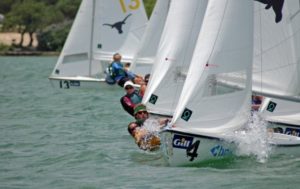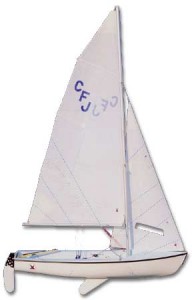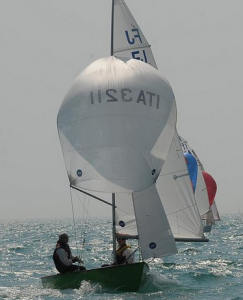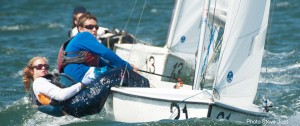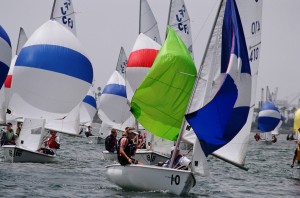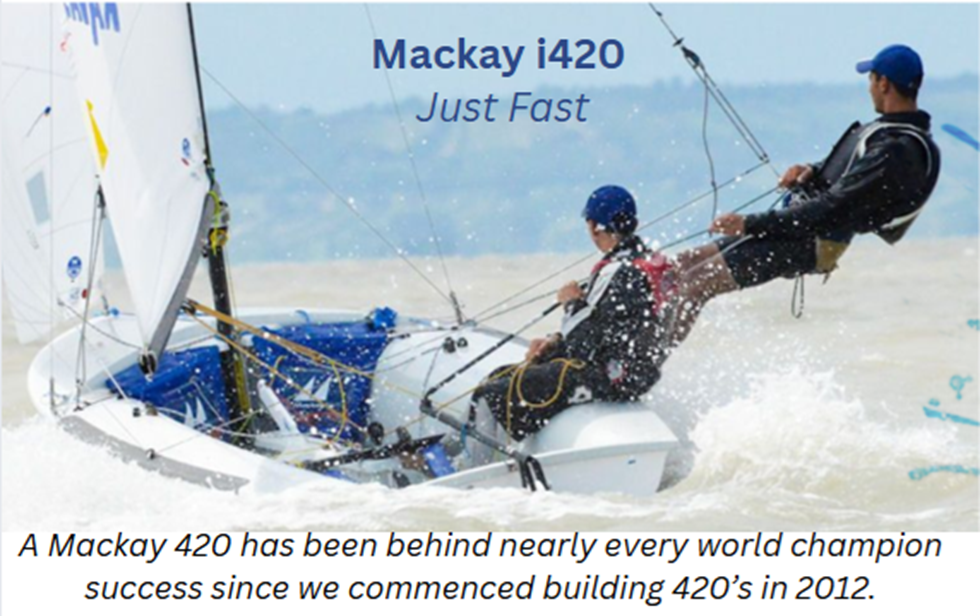PRES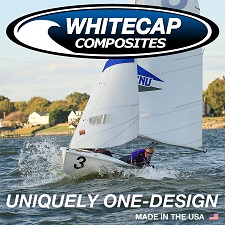
Whitecap Composites is pleased to announce that we have been granted a builder’s license from the Club FJ Class Association. A boat had been sent to the US Sailing Center in Long Beach, CA for measurement. It was also sailed in a number of regattas to evaluate its performance.
We look forward to being involved in the future of the class for many years to come.
Whitecap Composites Inc.
Whitecap Composites, Inc. is a team of passionate sailors, racers, and boat builders. They began their business back in 2011 when they were approached by a number of institutional coaches who felt collegiate racing would benefit from boats with improved structural integrity, a higher level of consistency, and a more performance-oriented feel. Whitecap Composites has the flexibility to incorporate any custom requests into their boats as they have learned that individual groups use their boats differently.
Currently, Whitecap Composites builds collegiate boats including the collegiate FJ, 420, Tech Dinghy, and the Lark. Now, with this new builder’s license, they will be building Club FJ’s. We talked with Paul Zimmerman from Whitecap Composites for a little Q and A on this new venture.
Why did Whitecap want to start building Club FJ’s?
First, we would like to clarify the difference between the Club FJ and the Collegiate FJ. The Club FJ must adhere to a specific set of class rules which define physical measurements, overall weight, and construction materials. Whereas the collegiate FJ can include features specific to a customer’s requirements and can be built to withstand a higher rate of collisions that the boats are subjected to in a college environment.
Now to answer your question, Whitecap Composites was initially approached by a number of schools to develop a lighter, stiffer, and more 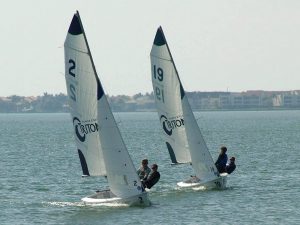
We felt that the West Coast market which predominantly sails the Club FJ could also benefit from what we had developed for other fleets in the country. So we applied what we learned with the Collegiate FJ to meet the specifics of the Club FJ class rules which addresses weights, hardware locations, and construction materials. The Class Association was very receptive to the possibility of a new builder and accepted our request to present a boat for their consideration.
Are you going to do anything different to make the Club FJ stand out from other boat builders?
In addition to the technical aspects, we wanted to provide a service that was attentive to the needs of schools and programs that require a quick response to all aspects of delivering new boats, including service after the sale was made and the boats were delivered. The number one goal is to keep the boats on the water sailing and not out of service.
Are there any clubs, teams, sailing centers interested in buying Club FJ’s from you already?
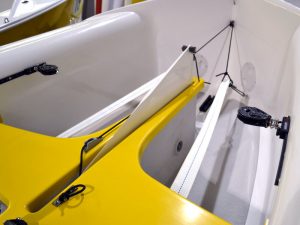
For more information on Whitecap Composites check out their website: http://www.whitecapcomposites.com/index.php And for questions regarding the new Club FJ’s they will be building Contact Paul Zimmerman at [email protected]
club FJ
One Design Spotlight: Club Flying Junior
Club FJ (Flying Junior): Youth Trainer Extraordinaire, by Airwaves writer Tyler Colvin
Recognizable to many youth sailors who grew up on lakes, ponds, or on the west coast, the Club Flying Junior (CFJ) is often used instead of C420s in youth sailing and collegiate programs. Originating in the mid 20th century in the Netherlands, it has spread to many clubs across the United States. The CFJ’s characteristics have made it a very popular on the west coast and on inland sailing venues.
The Boat: CFJ, Light Air Machine
The CFJ is a light, maneuverable boat at 13 feet long, 4 feet wide and weighing in around 220 lbs. Slightly shorter, narrower and lighter than the C420, the CFJ is designed to go upwind, fast. Narrow bow entry and a more rounded hull shape than the C420 means better upwind feel at the sacrifice of the ease of planing. A three-sail boat, the CFJ has a smaller main, larger jib and smaller spinnaker than the C420. The main sail is trimmed from the traveler bar in the cockpit and instead of having a mainsheet bridle to change trim angle, there is a traveler, which can be slid to windward or leeward. Additionally, jib trim angle can be adjusted from sliding jib block cars.
With only several thousand hulls in the water (as opposed to the nearly 8000 C420) internationally, the 2014 US National Championship saw a 53-boat fleet from mostly California based programs. In 2013, the World Championships in Germany had 57 boats from European countries.
Set Up and Sailing: Upwind Groove
While not nearly as much data exists for CFJ tuning as does for the C420, reliable tuning guides can be found from several sources (https://sail1design.com/wp-content/uploads/2014/08/NorthSails_FJTuningGuide.pdf) and here (https://sail1design.com/wp-content/uploads/2014/08/FJTuningGuide.pdf). Similar to the C420, mast rake and tension affects power in the rig and is adjusted from the chain plates and jib halyard tension respectively. Mast butt position is adjusted slightly to help the mast tip get forward or back.
Upwind the CFJ is lively and quick. It likes to point and drives off the large jib much more so than the C420. Traveler should be adjusted so that when the main is centerline, the top batten is parallel, or as close as possible, to the boom. This means traveler up in light air and back down towards the center as the wind increases. Jib trim is a very dynamic process in the CFJ. Car position should be adjusted so that the telltales both break evenly.
Because of its weight and hull shape, the CFJ responds well to boat handling and smooth maneuvers. It is very susceptible to side slip if not kept flat, which puts a premium on crew position. Because of the relatively wide transom, getting combined weight forward in lighter conditions is very important to break the suction that can occur. Driving the CFJ requires a light hand and a willingness to point to keep it in the optimum upwind “groove”.
Off the wind the CFJ will plane on main and jib alone, however for deep downwind sailing the spinnaker is used. Similar to the C420, the CFJ spinnaker is launched from a bow basket and flown by the crew. It is very important to keep the spinnaker round and full in order to maximize the sail shape.
Class Association: International Recognition
The CFJ class would be shortchanged if recognition of its international status was denied. The International Flying Junior Class Association (http://ifjo.org/) services the needs of this internationally raced one design class. Coordinating national, regional, continental and world championships, the class association has its hands full with the litany of participants from all of the major European countries as well as the United States and several others.
All one-design classes do not necessarily enjoy international class status. The C420 is not an international class, owing that honor to its close relative the International 420 (I420). International appeal means events can have a wide range of sailors from all over the world. It also means that events can require a bit of travel. Having a relatively small number of hulls (compared to the C420, Optimist, or Laser) in a large number of places can mean travel headaches for some wishing to compete on the regional or world stages.
Why the CFJ?
Talk to many collegiate sailors and they may tell you that they prefer racing the CFJ to the Collegiate 420. Talk to many west coast and European sailors and they won’t know anything else. Either way, the point is that the CFJ provides fast, exhilarating sailing in a responsive and nimble dingy unlike anything else its size. From junior sailors to college All-Americans, something must be right about the boat to keep them coming back for more.
To learn more about the c420, read our class profile!
Flying Junior
The “Flying Dutchman Junior” was originally designed, in Holland, by Van Essen, a well-known Dutch boat designer. Listed as codesigner was Conrad Gulcher, Dutch Olympic sailor. (Gulcher and Van Essen also collaborated on the Flying Dutchman Conrad Gulcher served as International Class Secretary for both classes for many years, and was a main driving force behind both the International Flying Dutchman, and International (FJ) Flying Junior classes until his death in 1989.
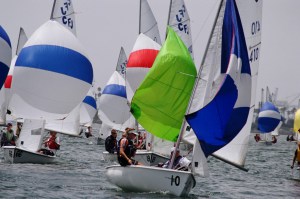
The original purpose of the “Flying Dutchman Junior” was to serve as a junior trainer for the then new Olympic Flying Dutchman (FD). The FD is a much larger( 19’10”), faster, and more physical class than its younger sister. The FJ rules also allowed (and still allow) many of the same technical innovations as the FD, and the boat was (and still is) ideal to teach newer sailors the intricacies of tuning, mast rake and bend, etc. so important to top-level competitive sailing.
The Class’ name was quickly changed to “Flying Junior” as the class developed on its own, and the Flying Junior Class Organisation was free and independent of the Flying Dutchman organisation by about 1960.
FJ Gets IYRU International Class Status
By the early 1970’s, the Flying Junior was accorded the status of an International Class by the International Yacht Racing Union (IYRU)- pre-cursor to the ISAF.
This prestigious status is applied only to sailing classes with strict one-design rules, that are sailed the world over, and that regularly have international competition- such as World and Continental Championships. The International Sailing Association (ISAF) (replacement organisation for the IYRU) currently governs the Class Rules of the International FJ Class. As an International Class, rights and control of the boat design rest with the International Sailing Federation (ISAF).
Today (2000), the International FJ is sailed in Japan, Germany, Italy, Belgium, The Netherlands, and the USA.
The Class Rules of the FJ allow any deck design; Dusseldorp FJs utilised a doublebottom design, especially suited to open-water sailing. Note the open transom, allowing large amounts of water to escape almost as fast as it can enter the hull. These hulls were the fastest FJs for at least the first 15 years of the Class’ existence. They are still competitive today.
From the beginning, the Class Rules of the FJ allowed any individual, or company to build the boat.
Class Rules Evolution- a summary of major revisions made to the Class Rules
- Early 1960’s, the Class Rules were modified to lengthen the mast, providing more speed, and clearance under the boom.
- Early 1970’s, the Flying Junior became the International Flying Junior. Accordingly, FJs built since 1972 must carry the IYRU “Builder Fee Paid” metal plaque permanently affixed in the cockpit, signifying that the IYRU royalty has been paid. These fees are the only source of income for the International Class.
- In 1980, recognizing that the name “Junior” did not accurately describe the current usage of the boat, the International Class changed the name to “International FJ”. 1980’s included a larger spinnaker (from 80 sq. ft. to about 88) and allowed shape cut into the sail (the original spinnaker rules required it to be two flat planes of cloth). Under the new rules, the bigger size, plus spherical cutting of spinnakers give a much faster sail.
- In 1990, the International Class added the trapeze for the crew, (added for the U.S. class in 1994). Officially, the crew must be at least 12 years of age to use the trapeze.
Under consideration, as of 1/1/00:a larger spinnaker, slightly larger main.
Class website:
http://www.cfjclass.org/
